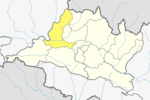Benighat Rorang Rural Municipality
On March 10, 2017, the Government of Nepal restructured the local level bodies into 753 new local level structures. The previous Mahadevsthan, Benighat, Dhusha and Jogimara VDCs were merged to form Benighat Rorang. Benighat Rorang is divided into 10 wards, with Benighat declared the administrative center of the rural municipality.
Demographics
At the time of the 2011 Nepal census, Benighat Rorang Rural Municipality had a population of 31,475. Of these, 58.0% spoke Nepali, 26.3% Chepang, 9.4% Tamang, 3.0% Magar, 1.1% Gurung, 0.6% Newar, 0.3% Bhojpuri, 0.3% Ghale, 0.2% Hindi, 0.2% Maithili, 0.2% Urdu, 0.1% Bhujel, 0.1% Rai, 0.1% Tharu and 0.1% other languages as their first language.
In terms of ethnicity/caste, 31.6% were Chepang/Praja, 11.2% Hill Brahmin, 10.5% Chhetri, 10.2% Tamang, 8.4% Magar, 7.0% Newar, 4.9% Kami, 4.0% Gurung, 2.9% Damai/Dholi, 2.6% Sarki, 1.7% Ghale, 1.7% Thakuri, 0.8% Sanyasi/Dasnami, 0.7% Musalman, 0.5% Gharti/Bhujel, 0.2% Brahmu/Baramo, 0.1% other Dalit, 0.1% Nuniya, 0.1% Rai, 0.1% Teli, 0.1% other Terai, 0.1% Tharu and 0.3% others.
In terms of religion, 75.6% were Hindu, 13.2% Buddhist, 8.0% Christian, 2.2% Prakriti, 0.7% Muslim and 0.2% others.
In terms of literacy, 62.9% could both read and write, 3.0% could read but not write and 34.0% could neither read nor write.
References
- ^ "District Corrected Last for RAJAPATRA" (PDF). www.mofald.gov.np. Retrieved 17 July 2018.
- ^ "स्थानीय तहहरुको विवरण" [Details of the local level bodies]. www.mofald.gov.np/en (in Nepali). Ministry of Federal Affairs and Local Development. Retrieved 17 July 2018.
- ^ "New local level structure comes into effect from today". www.thehimalayantimes.com. The Himalayan Times. 10 March 2017. Retrieved 17 July 2018.
- ^ "New local level units come into existence". www.kathmandupost.ekantipur.com. 11 March 2017. Retrieved 18 July 2018.
- ^ NepalMap Language [1]
- ^ NepalMap Caste [2]
- ^ NepalMap Religion [3]
- ^ NepalMap Literacy [4]
